
Imre Nagy was a Hungarian communist politician who served as Chairman of the Council of Ministers of the Hungarian People's Republic from 1953 to 1955. In 1956 Nagy became leader of the Hungarian Revolution of 1956 against the Soviet-backed government, for which he was sentenced to death and executed two years later.
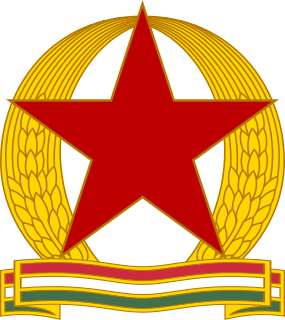
The State Protection Authority was the secret police of the People's Republic of Hungary from 1945 to 1956. The ÁVH was conceived as an external appendage of the Soviet Union's KGB in Hungary responsible for supporting the ruling Hungarian Working People's Party and persecuting political criminals. The ÁVH gained a reputation for brutality during a series of purges but was gradually reined under the government of Imre Nagy, a moderate reformer, after he was appointed Prime Minister of Hungary in 1953. The ÁVH was dissolved by Nagy's revolutionary government during the Hungarian Revolution of 1956 and succeeded by the Ministry of Internal Affairs III.

Árpád Göncz was a Hungarian writer, translator, agronomist, and liberal politician who served as President of Hungary from 2 May 1990 to 4 August 2000. Göncz played a role in the Hungarian Revolution of 1956, for which he was imprisoned for six years. After his release, he worked as a translator of English-language literary works.
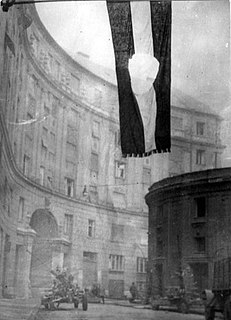
The Hungarian Revolution of 1956, was a countrywide revolution against the government of the Hungarian People's Republic (1949–1989) and the Hungarian domestic policies imposed by the USSR. Initially anarchic, the Hungarian Uprising of the Hungarian people culminated in protests against domestic policies imposed by the USSR, and the people formed together in protest against the Soviet Union.
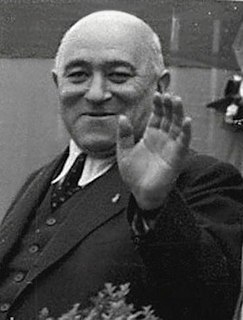
Mátyás Rákosi was a Hungarian communist politician who was the de facto leader of Hungary from 1947 to 1956. He served first as General Secretary of the Hungarian Communist Party from 1945 to 1948 and then as General Secretary of the Hungarian Working People's Party from 1948 to 1956.
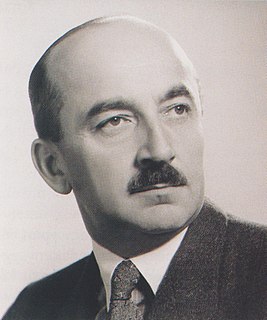
Ferenc Nagy was a Hungarian politician of the Smallholders Party who served as Prime Minister of Hungary from 1946 until his forced resignation in 1947. He was also a Speaker of the National Assembly of Hungary and a member of the High National Council from 1945 to 1946. Nagy was the second democratically elected prime minister of Hungary, and would be the last until 1990 not to be a Communist or fellow traveler. The subsequent Hungarian prime minister Imre Nagy was unrelated to him.

József Dudás, a Hungarian politician and resistance fighter, was born in Marosvásárhely in Austria-Hungary.

The Hungarian People's Republic was a one-party socialist state from 20 August 1949 to 23 October 1989. It was governed by the Hungarian Socialist Workers' Party, which was under the influence of the Soviet Union. Pursuant to the 1944 Moscow Conference, Winston Churchill and Joseph Stalin had agreed that after the war Hungary was to be included in the Soviet sphere of influence. The HPR remained in existence until 1989, when opposition forces brought the end of communism in Hungary.
Goulash Communism, also commonly called Kádárism or the Hungarian Thaw, is the variety of socialism in Hungary following the Hungarian Revolution of 1956. János Kádár and the Hungarian People's Republic imposed policies with the goal to create high-quality living standards for the people of Hungary coupled with economic reforms. These reforms fostered a sense of well-being and relative cultural freedom in Hungary with the reputation of being "the happiest barracks" of the Eastern Bloc during the 1960s to the 1970s. With elements of regulated market economics as well as an improved human rights record, it represented a quiet reform and deviation from the Stalinist principles applied to Hungary in the previous decade.

Dr. Béla Király was a Hungarian army officer before, during, and after World War II. After the war, he was sentenced to life in prison under the Soviet-allied regime, but was later released. After his release, he commanded the National Guard in the 1956 Hungarian Revolution. He then fled to the United States, where he became an academic historian. He returned to Hungary after the collapse of the Soviet Bloc and was elected a member of Hungarian Parliament.

The 2006 protests in Hungary were a series of anti-government protests triggered by the release of Hungarian Prime Minister Ferenc Gyurcsány's private speech in which he confessed that his Hungarian Socialist Party had lied to win the 2006 election, and had done nothing worth mentioning in the previous four years of governing. Most of the events took place in Budapest and other major cities between 17 September and 23 October. It was the first sustained protest in Hungary since 1989.

Gergely Pongrátz was a famous veteran of the Hungarian Revolution of 1956. He was the commander of arguably the largest and perhaps the best-known group of freedom fighters, at the Uprising's strongest and most lengthy point of resistance, Budapest's Corvin Passage ; between 1 and 9 November 1956. Under his command, the Corvin Passage fighters destroyed Soviet armored vehicles, and resisted several waves of assault. Following the conflict, Pongrátz escaped capture and by 1957 had moved to the United States where he spent the majority of his exile until returning to Hungary in 1991. During his exile he was elected both Vice-Chairman and then Chairman of the Hungarian Freedom Fighters' Association.
The following events occurred in October 1956:

The Stalin Monument was a statue of Joseph Stalin in Budapest, Hungary. Completed in December 1951 as a "gift to Joseph Stalin from the Hungarians on his seventieth birthday", it was torn down on October 23, 1956 by enraged anti-Soviet crowds during Hungary's October Revolution.

Hungarian–Soviet relations were characterized by political, economic, and cultural interventions by the Soviet Union in internal Hungarian politics for 45 years, the length of the Cold War. Hungary became a member of the Warsaw Pact in 1955; since the end of World War II, Russian troops were stationed in the country, intervening at the time of the Hungarian Revolution of 1956. Starting in March 1990, the Soviet Army began leaving Hungary, with the last troops being withdrawn on June 19, 1991.
The Hungarian Writers Union was founded in 1945 at the end of World War II. Initially the union was intended to be an organizational body through which the interests of writers in Hungary could be represented. It grew to become a major voice of dissension against the Communist regime in Hungary during the 1950s and had a significant role in sparking the Hungarian Revolution of 1956.
CIA involvement in Hungary from 1950-1957 and again in 1989 consisted of clandestine intelligence collection, gray psychological operations, and counterintelligence activities. As noted in the book Broadcasting Freedom: The Cold War Triumph of Radio Free Europe and Radio Liberty, an organization called Radio Free Europe (RFE), was funded at the time by the CIA to broadcast Hungary from at least from 1950 to 1956. However, RFE operated on no directives to foment revolution.
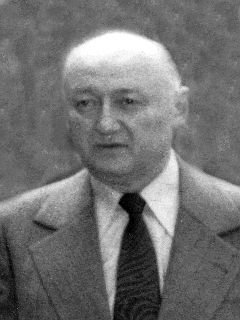
Béla Biszku was a Hungarian communist politician, who served as Minister of the Interior from 1957 to 1961. He was charged of suspicion of committing war crimes during the suppression of the Hungarian Revolution of 1956, becoming the first and to date only former top-official in Hungary who has been prosecuted because of political role in the communist era.

The Battle of the Corvin Passage was a battle fought in the Hungarian Revolution of 1956. It proved to be one of the most important battlegrounds during the war. A statue can be found at Corvin köz, near Corvin–negyed, to mark this important event in the Hungarian Revolution of 1956. The battle is known for starting the career of Gergely Pongrátz, founder of Jobbik.
The following is a timeline of the history of the city of Budapest, Hungary.